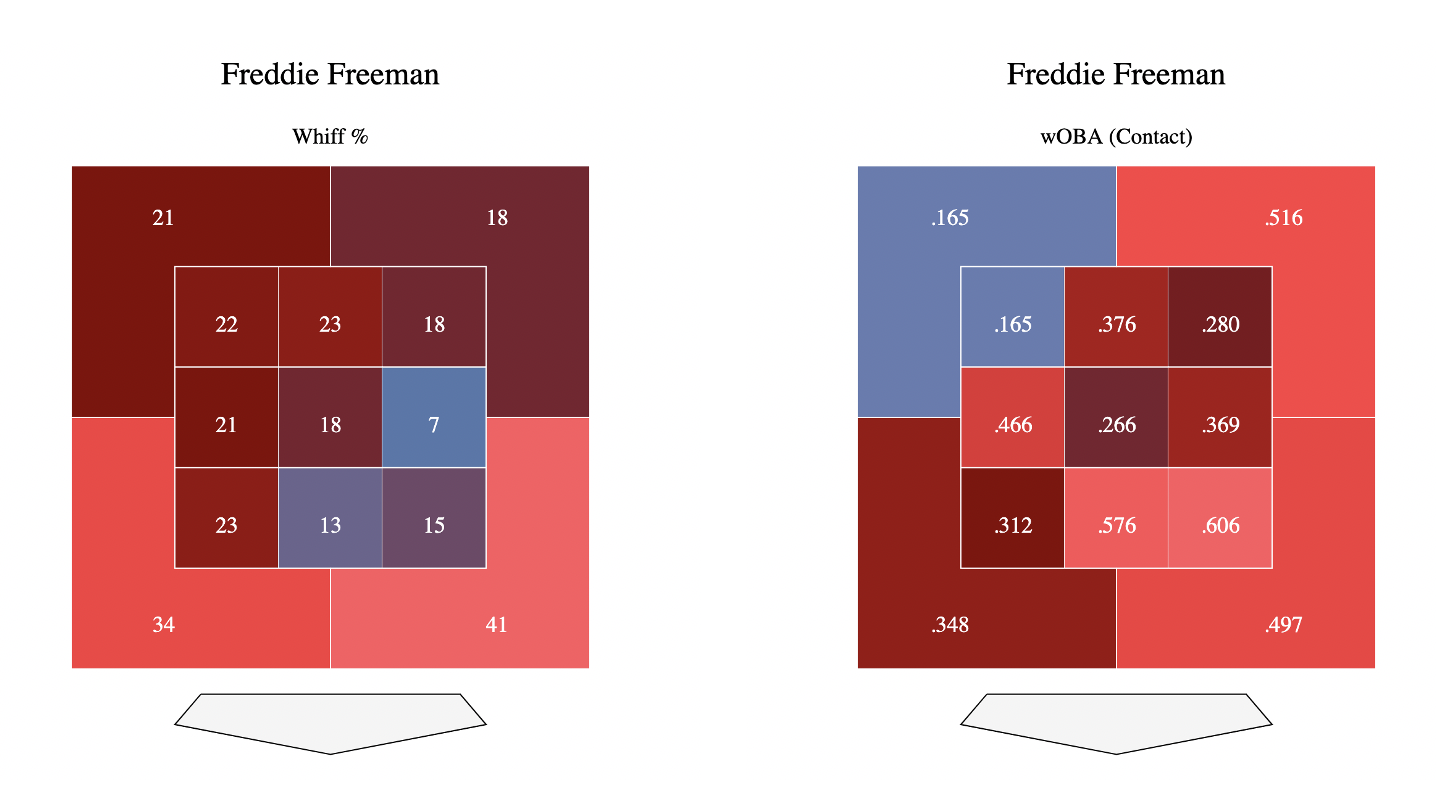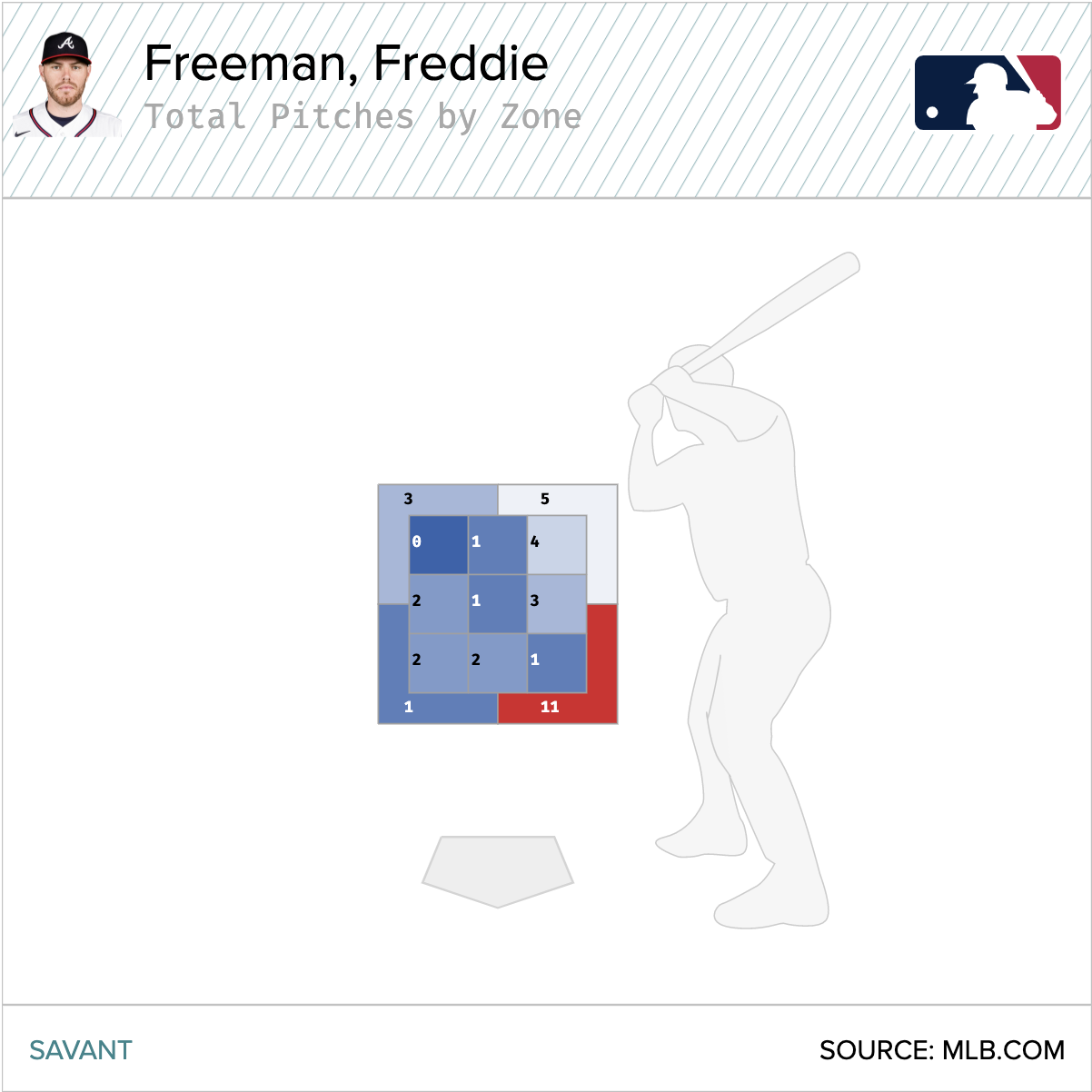The Dodgers Have a Book on Freddie Freeman
Through two games of the NLCS, Freddie Freeman has been a complete non-factor for the Braves, making it that much more surprising that they’re just two wins away from the World Series. In eight trips to the plate, he has no hits and seven strikeouts; his 0-for-4 with four strikeouts in Game 1 made him Atlanta’s least-valuable hitter by win probability added, at -.148. At least in Game 2, with another 0-for-4 (this time with three punchouts), he was only Atlanta’s second-least valuable hitter by WPA at -.151.
The postseason forces us to look at tiny samples, but Freeman striking out in seven consecutive plate appearances tied his career high. Adding to the improbability of it all, he has struck out three or more times in one game in just 19 of the 639 he’s played with three or more plate appearances since the start of 2017. For context, Joey Gallo (21), Javier Báez (21), Randy Arozarena (21), and Matt Chapman (20) had more three-plus-strikeout games this season.
For what it’s worth, Freeman isn’t at the top of the league in avoiding the three-strikeout game, even if it is indeed rare for him. Among the 285 players with at least 250 three-plate appearance games since the beginning of 2017, his three-strikeout game rate of 3.0% ranks 101st. Two players, Jonathan Lucroy and Eduardo Núñez, did not have any three-strikeout games in this stretch, and another six had just one. While he’s above the median in this stat, Freeman isn’t a player who will avoid the strikeout entirely; after all, he has struck out in 17.4% of his plate appearances in the last five years, a figure that’s better than the league average but not among the lowest rates in the game.
But seven strikeouts in two games? This isn’t Gallo here; it’s still absurd for Freeman to strike out this much in such a short span. Only twice in his career has he struck out at least three times in back-to-back games, and he’s struck out in seven consecutive plate appearances just two times before as well. Let’s break down how Dodgers pitching has done it so far.

That’s a lot on the inner half of the plate to the lefty-hitting Freeman. The out pitches themselves have varied across the strike zone, though notably, four of the seven strikeout pitches were sliders. Blake Treinen got Freeman to strike out on a slider in Game 1; in Game 2, Max Scherzer got him twice on that pitch (once looking, once swinging), and Alex Vesia got him swinging on it later that night. A lot of this is pitcher-dependent, but the Dodgers have provided Freeman with a healthy diet of sliders overall through two games — nine of the 36 pitches he has seen so far this series.
This does seem to be following a script of some sort, though I’m sure the Dodgers did not expect Freeman to strike out seven times. That’s just lucky. But feeding him sliders, especially when he’s behind in the count, might have been a big part of the game plan. Since 2015, to look just at data within the Statcast era, he has a 37% whiff rate against sliders, his highest rate against any pitch type, minimum 100 swings:
| Pitch Type | Whiffs | Swings | Whiff% |
|---|---|---|---|
| Slider | 468 | 1,275 | 37% |
| Split-Finger | 50 | 148 | 34% |
| Changeup | 352 | 1,112 | 32% |
| Cutter | 123 | 473 | 26% |
| Curveball | 133 | 542 | 25% |
| Knuckle Curve | 36 | 147 | 24% |
| 4-Seam Fastball | 564 | 2,908 | 19% |
| Sinker | 156 | 862 | 18% |
| 2-Seam Fastball | 107 | 635 | 17% |
And out of all nine of these pitch types, he has the lowest expected wOBA against sliders:
| Pitch Type | BA | SLG | wOBA | xwOBA |
|---|---|---|---|---|
| Slider | .239 | .399 | .322 | .325 |
| Cutter | .289 | .421 | .343 | .343 |
| Changeup | .270 | .448 | .343 | .362 |
| Curveball | .297 | .598 | .399 | .383 |
| Sinker | .307 | .496 | .382 | .409 |
| 4-Seam Fastball | .321 | .614 | .424 | .447 |
| Knuckle Curve | .377 | .594 | .454 | .472 |
| 2-Seam Fastball | .399 | .733 | .494 | .492 |
It’s probably not a coincidence that Freeman has seen quite a few sliders this series, but as mentioned, much of that remains pitcher-dependent. Across all pitchers he faced this year, he saw a slider 16.5% of the time, so seeing nine in 36 pitches, or 25%, is about three over what would be expected from his regular-season rate. That’s probably enough to conclude the Dodgers did want to emphasize sliders when pitching to him, but it doesn’t mean that they’ve discovered his long-hidden kryptonite in just two games. He’ll be fine, but it’s still worth noting how they’ve approached him, pitch type-wise.
The abundance of inside pitches doesn’t fit nearly as nice into a broader context. Inside the strike zone, Freeman is much better with pitches on the inner half than the outer, and this season, low and in was his favorite part of the zone, with his lowest whiff rate and highest expected wOBA on contact. You have to be super, super careful if you’re going to try pitching to him there:

But as you can see in the above chart, the Dodgers have tried to pitch him low and in without bleeding into the strike zone. Grouping the above pitch chart into the zones we see in the whiff and xwOBAcon charts, you can see that this has been a pointed plan of attack against him:

Of the 36 pitches Freeman has seen in this series, 11 of them have come in the out-of-zone, low-and-in area. And for some reason, he has swung at six of them, a 55% rate; in the regular season, he swung at about one-third of pitches there. On these six swings, he whiffed thrice and fouled off the other three; no damage done there. And on one of the takes, the Dodgers even got lucky with a called strike. In the regular season, about one-quarter of pitches in that zone were whiffs, fouls, or called strikes. The Dodgers have gotten those results from seven of the 11 there so far.
Therein lies both the beauty and the issues with postseason baseball. For one, it’s fun to break this type of stuff down at the pitch level. Did we figure out the Dodgers’ plan for Freeman? Maybe. Has it worked? It certainly seems like it. In order to strike him out seven times in two games, did they also get lucky? Of course; there’s a ton of variability in small samples. Do I think Freeman or the Braves care? Perhaps to prepare for what’s to come in the rest of the series, sure. But with a 2–0 lead in the series, I’d be willing to bet that he’s happy to trade seven strikeouts for being two wins away from the World Series. While the Dodgers might have figured out how to get him out, so far, it hasn’t really mattered.
Devan Fink is a Contributor at FanGraphs. You can follow him on Twitter @DevanFink.

The title here is a bit clickbait-y as really it is pretty silly to suggest any team has “a book” on a hitter based on two games of data. The article itself doesn’t even make that claim.
I’d be interested in knowing about the sequencing. From watching, it feels like the Dodgers I’ve done a good job of changing eye level and avoiding repeating pitches too much. I wonder if that is true?
But really, I don’t think anyone is worried about Freddie Freeman and despite one strange comment on the last recap about walking Rosario to face Freeman, there is no more dangerous hitter in the Braves lineup and everyone on both teams knows that.